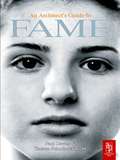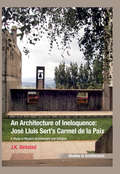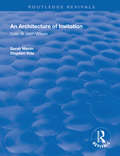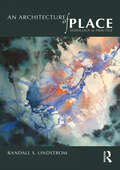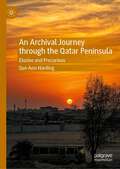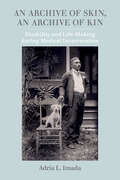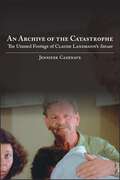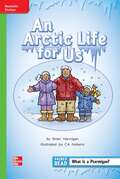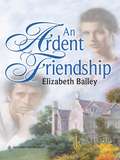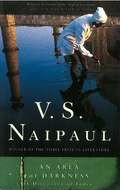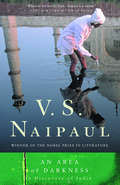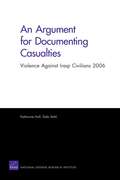- Table View
- List View
An Architect's Guide to Fame
by Paul Davies Torsten SchmiedeknechtThis lively text provides a candid inquiry into the contemporary means by which architects get work and (for better or worse) become famous. In response to the reciprocal relationship between publicity and everyday architectural practice, this book examines the mechanisms by which architects seek publicity and manage to establish themselves and their work ahead of their colleagues. Through the essays of specialist contributors, this book enables the reader to understand the complex relationship between what they see as the built environment and the unwritten stories behind how it came about.
An Architect's Guide to Public Procurement
by Fin GarveyThere is suspicion in the UK and across Europe that the upcoming introduction of new European Directives will encourage a regime of conservatism and legal risk aversion, fostering the delivery of mediocre and banal building design. This book dispels these myths and instead looks at the genuine impact of EU law on architectural practice.Engaging in public sector work requires a broad understanding of this seemingly complex and constantly evolving subject, and unlike other texts, the book is designed to explore public procurement from the perspective of the architect. An easy to follow guide through the complex legal and technical jargon involved in the procurement process, the book provides practical tools which will assist architects in developing their own, clear procurement strategy.Although written with a UK audience in mind, the advice will also be applicable to other European jurisdictions. It is invaluable reading for existing practitioners wishing to expand their current involvement in the public procurement process, as well as those encountering it for the first time.
An Architectural Approach to Instructional Design
by Andrew S. GibbonsWinner of the 2014 AECT Design & Development Outstanding Book Award An Architectural Approach to Instructional Design is organized around a groundbreaking new way of conceptualizing instructional design practice. Both practical and theoretically sound, this approach is drawn from current international trends in architectural, digital, and industrial design, and focuses on the structural and functional properties of the artifact being designed rather than the processes used to design it. Harmonious with existing systematic design models, the architectural approach expands the scope of design discourse by introducing new depth into the conversation and merging current knowledge with proven systematic techniques. An architectural approach is the natural result of increasing technological complexity and escalating user expectations. As the complexity of design problems increases, specialties evolve their own design languages, theories, processes, tools, literature, organizations, and standards. An Architectural Approach to Instructional Design describes the implications for theory and practice, providing a powerful and commercially relevant introduction for all students of instructional design.
An Architecture Manifesto: Critical Reason and Theories of a Failed Practice
by Nadir LahijiWhat is a manifesto? In basic terms, a manifesto is ‘the invention of future for the present’. We have been oblivious to the fact that the twentieth century was the century of manifestos. It was the century of programmatic declarations, radical and avant-garde political, artistic and architectural proclamations. Manifestos came to be a genre of concise and radical-critical writings exposing the repressed contradictions in a dominant doctrine. They opened up the present to the future by denouncing the forces of the status quo and offering alternative programs. Today, this genre is a more valid, even urgent, form of writing for our time, in order to expose the dominant doctrine that has closed the future in subscribing to the ideology of the ‘end of history’. In this manifesto, Nadir Lahiji takes a leap of faith. It is a faith in Lost Causes. He asserts that today, architectonic reason has fallen into ruins. As soon as architecture leaves the limits set to it by architectonic reason, no other path is open to it but the path to aestheticism. This is the wrong path contemporary architecture has taken. In its reduction to a pure aesthetic object, architecture negatively affects the human sensorium. Capitalist consumer society creates desires by generating ‘surplus-enjoyment’ for capitalist profit and contemporary architecture has become an instrument in generating this ‘surplus-enjoyment’, with fatal consequences. This manifesto is thus both a critique and a work of theory. It is a siren, alarm, klaxon to the current status quo within architectural discourse and a timely response to the conditions of architecture today.
An Architecture of Care in South Africa: From Arts and Crafts to Other Progeny (Routledge Research in Architecture)
by Nicholas CoetzerArchitects care. It is foundational and germane to the discipline and practice of architecture. This book charts the way the Arts and Crafts Movement established the moral ethos of ‘an architecture of care’ that not only remains embedded in current discourse and practice but also that is being given a more vocal presence in our climate-crisis and social justice world. By way of ‘genealogical strands’ the book charts the origin of ‘architecture of care’ ideas in the Arts and Crafts Movement and their impact on the ‘other progeny’ architectural projects in South Africa over the past hundred years. These range from the translation of inglenooks into an armature architecture of ‘Dignified Places’ in Cape Town’s townships to the ethos of ‘upliftment’ and care that translates from Octavia Hill through to ‘correcting’ building regulations and eventually finding a less moralising and more transformative impact in the ‘Hostels to Homes’ project. The birth of design through context and climate in the Arts and Crafts Movement is demonstrated by the shift in South African houses from boxy cottages to solar- and nature-oriented ribbon plans as demonstrated through the work of Helmut Stauch and Norman Eaton. The dislocation of Arts and Crafts ideas to the Cape also demonstrated a limit to the valorising of vernacular architecture and its ‘against-globalization’ building materials whereby English architects promoted Cape Dutch settler architecture and denigrated African vernacular architecture. As a final ‘genealogical strand,’ the book demonstrates the coherence of moral instrumentality with the animism and affects potential of handmade buildings. Written for academics, students and researchers interested in architectural history, it is an eye-opening investigation into the role of architecture in society.
An Architecture of Ineloquence: A Study in Modern Architecture and Religion (Ashgate Studies in Architecture)
by J.K. BirkstedSet on a hillside near Cluny, in a region associated with religious institutions and sacred architecture (including Le Corbusier's La Tourette), Le Carmel de la Paix, designed by José Luis Sert, remains tranquilly unvisited and quietly erased from architectural history. Why? This unusual convent falls outside the standard categories of Sert's architecture and has been overlooked in most publications about his work. As J.K. Birksted explains, the design and construction process for this building proved nightmarish, resulting in a building which, at first sight, appears to be 'ineloquent'. This first detailed examination of this building shows how the convent and the story of its creation offer valuable and important new insights into Sert, his architecture and his life. However, the study also opens up discussions on wider subjects such as the relationships between modernist architecture and ecclesiastical architecture. The design and construction of the Carmel de la Paix (1968-1972) followed the Second Ecumenical Council of the Vatican (1962-1965), which introduced fundamental changes and proposals for renewing the relationship between the Church and the changing modern world and the convent provides an interesting illustration of this period. In addition, it offers insights into the fascinating world of the Carmelite order and its specific liturgical requirements, and, reflecting on the nuns' active involvement in the design and construction process, it also explores wider issues of women in architecture.
An Architecture of Invitation: Colin St John Wilson (Routledge Revivals)
by Stephen Kite Sarah MeninFirst published in 2005, An Architecture of invitation: Colin St John Wilson is a distinctive study of the life and architectural career of one of the most significant makers, theorists and teachers of architecture to have emerged in England in the second half of the twentieth century. Exceptionally in an architectural study, this book interweaves biography, critical analysis of the projects, and theory, in its aims of explicating the richness of Wilson’s body of work, thought and teaching. Drawing on the specialisms of its authors, it also examines the creative and psychological impulses that have informed the making of the work – an oeuvre whose experiential depth is recognised by both users and critics.
An Architecture of Parts: Architects, Building Workers, And Industrialization In Britain, 1940-1970 (Routledge Research in Architecture)
by Christine WallThis book is unique in describing the history of post war reconstruction from an entirely new perspective by focusing on the changing relationship between architects and building workers. It considers individual, as well as collective, interactions with technical change and in doing so brings together, for the first time, an extraordinary range of sources including technical archives, oral history and visual material to describe the construction process both during and in the decades after the war. It focuses on the social aspects of production and the changes in working life for architects and building workers with increasing industrialization, in particular analysing the effect on the building process of introducing dimensionally co-ordinated components. Both architects and building workers have been accused of creating a built environment now popularly discredited: architects responsible for poor design and building workers for poor workmanship. However, many of the structures and ideas underpinning this period of rapid change were revolutionary in their commitment to a complete transformation of the building process. An Architecture of Parts adds to the growing literature on changes in the building world during and immediately after the Second World War. It is significant, both empirically and historically, in its examination of the ideas, technology and relationships that fired industrialization of the building process in mid-century Britain.
An Architecture of Place: Topology in Practice
by Randall S. LindstromChallenging mainstream architecture’s understandings of place, this book offers an illuminating clarification that allows the idea’s centrality, in all aspects of everyday design thinking, to be rediscovered or considered for the first time.Rigorous but not dense, practical but not trivialising, the book unfolds on three fronts. First, it clearly frames the pertinent aspects of topology—the philosophy of place—importantly differentiating two concepts that architecture regularly conflates: place and space. Second, it rejects the ubiquitous notion that architecture “makes place” and, instead, reasons that place is what makes architecture and the built environment possible; that place “calls” for and to architecture; and that architecture is thus invited to “listen” and respond. Finally, it turns to the matter of designing responses that result not just in more places of architecture (demanding little of design), nor merely in architecture with some “sense of place” (demanding little more), but, rising above those, responses that constitute an architecture of place (demanding the greatest vigilance but offering the utmost freedom).Opening up a term regarded as so common that its meaning is seldom considered, the author reveals the actual depth and richness of place, its innateness to architecture, and its essentiality to practitioners, clients, educators, and students—including those in all spatial disciplines.
An Architecture of the Mind: A Psychological Foundation for the Science of Everyday Life
by Brendan Markey-TowlerAn Architecture of the Mind proposes a mathematically logical and rigorous theory of lived experience, and a comprehensive and coherent theory of psychology. It is also remarkably simple. Building on the core proposition that the mind is a network structure, it proposes a theory of the psychological process as operating within and upon that structure, and a theory of behaviour as determined by that process. The theory presents a view of the mind which reveals a new perspective on the process of reasoning in thinking and how it may coexist with processes more akin to simple rule-following and computation. It allows us to understand the role and influence of social influences in the psychological process by revealing their role in and influence on mental networks. It reveals the place of motivations in the psyche as complexes in mental networks from whence aesthetics, preference and value judgements arise and demonstrates their necessity for behaviour. This book is especially useful for the perspective it offers on behavioural change. It reveals the conditions under which traditional economic theories of incentives will be appropriate, and the conditions under which they will not be. This book draws on psychology, social science, cultural science, neuroscience and economics to offer an interdisciplinary contribution which resists the tendency for disciplines to become over-specialised and fragmented. It will be of interest to any interested in the functioning of the human mind and the government of human behaviour.
An Archival Journey through the Qatar Peninsula: Elusive and Precarious
by Sue-Ann HardingThis book retrieves from the archives people, places and perspectives normally overlooked to tell an original and expansive history of the Qatar Peninsula, paying close attention to landscape and the natural world. The arc of the book moves geographically through the landscape and chronologically through selected sources, drawing on digitised maps, manuscripts, hydrographic surveys, government records, traveller accounts, early photographs, archaeological and ethnographic reports. While these are standard sources recruited by Qatar to tell its own singular, streamlined history, this book is a subversive reading of those sources. It braids together elusive and precarious stories – difficult to find, at risk of being lost, and never before brought together into a single volume – to write a more complicated story of place. Through them, we can reimagine a place that, like many in the world, works hard to control a limited set of stories about itself. Readers who know something about Qatar will be surprised by the book’s nuances and details. Readers who know little or nothing will be drawn in to discover that, even in the most out-of-the-way and inhospitable places, deserts are never empty.
An Archive of Feelings: Trauma, Sexuality, and Lesbian Public Cultures
by Ann CvetkovichIn this bold new work of cultural criticism, Ann Cvetkovich develops a queer approach to trauma. She argues for the importance of recognizing--and archiving--accounts of trauma that belong as much to the ordinary and everyday as to the domain of catastrophe. An Archive of Feelings contends that the field of trauma studies, limited by too strict a division between the public and the private, has overlooked the experiences of women and queers. Rejecting the pathologizing understandings of trauma that permeate medical and clinical discourses on the subject, Cvetkovich develops instead a sex-positive approach missing even from most feminist work on trauma. She challenges the field to engage more fully with sexual trauma and the wide range of feelings in its vicinity, including those associated with butch-femme sex and aids activism and caretaking. An Archive of Feelings brings together oral histories from lesbian activists involved in act up/New York; readings of literature by Dorothy Allison, Leslie Feinberg, Cherre Moraga, and Shani Mootoo; videos by Jean Carlomusto and Pratibha Parmar; and performances by Lisa Kron, Carmelita Tropicana, and the bands Le Tigre and Tribe 8. Cvetkovich reveals how activism, performance, and literature give rise to public cultures that work through trauma and transform the conditions producing it. By looking closely at connections between sexuality, trauma, and the creation of lesbian public cultures, Cvetkovich makes those experiences that have been pushed to the peripheries of trauma culture the defining principles of a new construction of sexual trauma--one in which trauma catalyzes the creation of cultural archives and political communities.
An Archive of Hope: Harvey Milk's Speeches and Writings
by Frank M. Robinson Charles E. Morris III Jason Edward Black Harvey MilkHarvey Milk was one of the first openly and politically gay public officials in the United States, and his remarkable activism put him at the very heart of a pivotal civil rights movement reshaping America in the 1970s. An Archive of Hope is Milk in his own words, bringing together in one volume a substantial collection of his speeches, columns, editorials, political campaign materials, open letters, and press releases, culled from public archives, newspapers, and personal collections. The volume opens with a foreword from Milk's friend, political advisor, and speech writer Frank Robinson, who remembers the man who "started as a Goldwater Republican and ended his life as the last of the store front politicians" who aimed to "give 'em hope" in his speeches. An illuminating introduction traces GLBTQ politics in San Francisco, situates Milk within that context, and elaborates the significance of his discourse and memories both to 1970s-era gay rights efforts and contemporary GLBTQ worldmaking.
An Archive of Possibilities: Healing and Repair in Democratic Republic of Congo (Critical Global Health: Evidence, Efficacy, Ethnography)
by Rachel Marie NiehuusIn An Archive of Possibilities, anthropologist and surgeon Rachel Marie Niehuus explores possibilities of healing and repair in the eastern Democratic Republic of Congo against a backdrop of 250 years of Black displacement, enslavement, death, and chronic war. Niehuus argues that in a context in which violence characterizes everyday life, Congolese have developed innovative and imaginative ways to live amid and mend from repetitive harm. Drawing on ethnographic fieldwork and the Black critical theory of Achille Mbembe, Christina Sharpe, Alexis Pauline Gumbs and others, Niehuus explores the renegotiation of relationships with land as a form of public healing, the affective experience of living in insecurity, the hospital as a site for the socialization of pain, the possibility of necropolitical healing, and the uses of prophesy to create collective futures. By considering the radical nature of cohabitating with violence, Niehuus demonstrates that Congolese practices of healing imagine and articulate alternative ways of living in a global regime of antiblackness.
An Archive of Skin, An Archive of Kin: Disability and Life-Making during Medical Incarceration (American Crossroads #62)
by Adria L. ImadaWhat was the longest and harshest medical quarantine in modern history, and how did people survive it? In Hawaiʻi beginning in 1866, men, women, and children suspected of having leprosy were removed from their families. Most were sentenced over the next century to lifelong exile at an isolated settlement. Thousands of photographs taken of their skin provided forceful, if conflicting, evidence of disease and disability for colonial health agents. And yet among these exiled people, a competing knowledge system of kinship and collectivity emerged during their incarceration. This book shows how they pieced together their own intimate archives of care and companionship through unanticipated adaptations of photography.
An Archive of Taste: Race and Eating in the Early United States
by Lauren F. KleinA groundbreaking synthesis of food studies, archival theory, and early American literature There is no eating in the archive. This is not only a practical admonition to any would-be researcher but also a methodological challenge, in that there is no eating—or, at least, no food—preserved among the printed records of the early United States. Synthesizing a range of textual artifacts with accounts (both real and imagined) of foods harvested, dishes prepared, and meals consumed, An Archive of Taste reveals how a focus on eating allows us to rethink the nature and significance of aesthetics in early America, as well as of its archive.Lauren F. Klein considers eating and early American aesthetics together, reframing the philosophical work of food and its meaning for the people who prepare, serve, and consume it. She tells the story of how eating emerged as an aesthetic activity over the course of the eighteenth century and how it subsequently transformed into a means of expressing both allegiance and resistance to the dominant Enlightenment worldview. Klein offers richly layered accounts of the enslaved men and women who cooked the meals of the nation&’s founders and, in doing so, directly affected the development of our national culture—from Thomas Jefferson&’s emancipation agreement with his enslaved chef to Malinda Russell&’s Domestic Cookbook, the first African American–authored culinary text.The first book to examine the gustatory origins of aesthetic taste in early American literature, An Archive of Taste shows how thinking about eating can help to tell new stories about the range of people who worked to establish a cultural foundation for the United States.
An Archive of the Catastrophe: The Unused Footage of Claude Lanzmann's Shoah (SUNY series in Contemporary Jewish Literature and Culture)
by Jennifer CazenaveHonorable Mention, 2020 Best First Book Award presented by the Society for Cinema and Media StudiesClaude Lanzmann's 1985 magnum opus, Shoah, is a canonical documentary on the Holocaust—and in film history. Over the course of twelve years, Lanzmann gathered 230 hours of location filming and interviews with survivors, witnesses, and perpetrators, which he condensed into a 9½-hour film. The unused footage was scattered and inaccessible for years before it was restored and digitized by the United States Holocaust Memorial Museum. In An Archive of the Catastrophe, Jennifer Cazenave presents the first comprehensive study of this collection. She argues that the outtakes pose a major challenge to the representational and theoretical paradigms produced by the documentary, while offering new meanings of Shoah and of Holocaust testimony writ large. They lend fresh insight into issues raised by the film, including questions of resistance, rescue, refugees, and, above all, gender—Lanzmann's twenty hours of interviews with women make up a mere ten minutes of the finished documentary. As a rare instance of outtakes preserved during the predigital era of cinema, this unused footage challenges us to establish a new critical framework for understanding how documentaries are constructed and reshapes the way we view this key Holocaust film.To view the book trailer on YouTube, please go to: https://www.youtube.com/watch?v=bBjUWyAn55g
An Ardent Friendship
by Elizabeth BaileyA Most Unusual PropositionMiss Timothia Dulverton had just finished mourning her dear departed father when she received a most unexpected proposal from her cousin, Mr. Leo Wetheral. Marriage? To Leo? Didn't they know each other too well for that? But Leo had a bargain for Timma. Since Dulverton House had been left to the male heir, Timma had nowhere to go. And Leo had Blentisham to run all by himself. Why not combine their resources and help each other out? But how could Timma say yes when she had always wanted to marry for love?
An Area of Darkness: A Discovery Of India
by V. S. NaipaulTHE FIRST BOOK IN V. S. NAIPAUL’S ACCLAIMED INDIAN TRILOGY An Area of Darknessis V. S. Naipaul’s semi-autobiographical account – at once painful and hilarious, but always thoughtful and considered – of his first visit to India, the land of his forebears. He was twenty-nine years old; he stayed for a year. From the moment of his inauspicious arrival in Prohibition-dry Bombay, bearing whisky and cheap brandy, he experienced a cultural estrangement from the subcontinent. It became for him a land of myths, an area of darkness closing up behind him as he travelled . . . The experience was not a pleasant one, but the pain the author suffered was creative rather than numbing, and engendered a masterful work of literature that provides a revelation both of India and of himself: a displaced person who paradoxically possesses a stronger sense of place than almost anyone. ‘Brilliant’ Observer ‘A masterpiece of travel-writing’ Paul Theroux ‘His narrative skill is spectacular. ’ The Times
An Area of Darkness: A Discovery Of India
by V. S. NaipaulThe Nobel Prize-winning author&’s profound reckoning with his ancestral homeland and an extraordinarily perceptive chronicle of his first encounter with India.&“Whatever his literary form, Naipaul is a master.&” —The New York Review of BooksTraveling from the bureaucratic morass of Bombay to the ethereal beauty of Kashmir, from a sacred ice cave in the Himalayas to an abandoned temple near Madras, Naipaul encounters a dizzying cross-section of humanity: browbeaten government workers and imperious servants, a suavely self-serving holy man and a deluded American religious seeker. An Area of Darkness also abounds with Naipaul&’s strikingly original responses to India&’s paralyzing caste system, its apparently serene acceptance of poverty and squalor, and the conflict between its desire for self-determination and its nostalgia for the British raj. The result may be the most elegant and passionate book ever written about the subcontinent.
An Area of Darkness: A Discovery of India
by V. S. NaipaulA classic of modern travel writing, "An Area of Darkness" is Nobel laureate V. S. Naipaul's profound reckoning with his ancestral homeland and an extraordinarily perceptive chronicle of his first encounter with India. Traveling from the bureaucratic morass of Bombay to the ethereal beauty of Kashmir, from a sacred ice cave in the Himalayas to an abandoned temple near Madras, Naipaul encounters a dizzying cross-section of humanity: browbeaten government workers and imperious servants, a suavely self-serving holy man and a deluded American religious seeker. "An Area of Darkness" also abounds with Naipaul's strikingly original responses to India's paralyzing caste system, its apparently serene acceptance of poverty and squalor, and the conflict between its desire for self-determination and its nostalgia for the British raj. The result may be the most elegant and passionate book ever written about the subcontinent.
An Areal Typology of Agreement Systems
by Ranko MatasovićSurveying over 300 languages, this typological study presents new theoretical insights into the nature of agreement, as well as empirical findings about the distribution of agreement patterns in the world's languages. <P><P>Focussing primarily on agreement in gender, number and person, but with reference to agreement in other smaller categories, Ranko Matasović aims to discover which patterns of agreement are widespread and common in languages, and which are rather limited in their distribution. He sheds new light on a range of important theoretical questions such as what agreement actually is, what areal, typological and genetic patterns exist across agreement systems, and what problems in the analysis of agreement remain unresolved.<P> Describes in detail the areal distribution of several patterns of agreement.<P> A useful resource for linguists working on areal typology and seeking evidence for prehistoric language contacts and genetic relationships.<P> All theoretical concepts are defined and clearly explained.
An Argument Open to All
by Sanford LevinsonIn "An Argument Open to All, " renowned legal scholar Sanford Levinson takes a novel approach to what is perhaps America's most famous political tract. Rather than concern himself with the authors as historical figures, or how "The Federalist" helps us understand the original intent of the framers of the Constitution, Levinson examines each essay for the "political" wisdom it can offer us today. In eighty-five short essays, each keyed to a different essay in "The Federalist, " he considers such questions as whether present generations can rethink their constitutional arrangements; how much effort we should exert to preserve America's traditional culture; and whether "The Federalist"'s arguments even suggest the desirability of world government. "
An Argument for Documenting Casualties
by Dale Stahl Katharine HallThis study examines available open-source data on Iraqi civilian fatalities and assesses problems associated with previous collection efforts. The authors present a new and more robust RAND Corporation Iraqi civilian violence dataset from which they derive observations about trends in targeting and weapons in 2006. These findings lead to a proposed framework for future civilian fatality data-collection efforts in Iraq and beyond.
